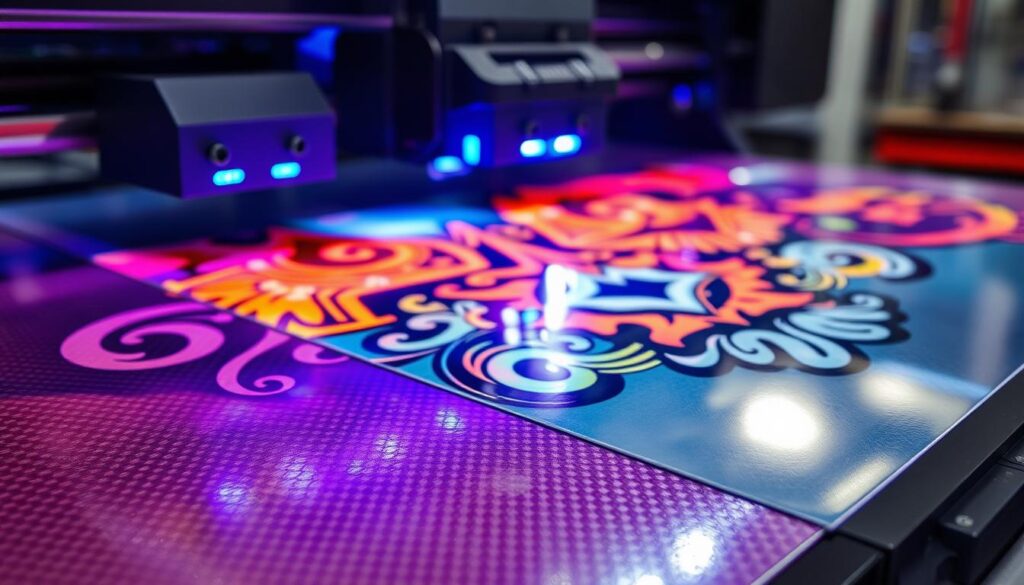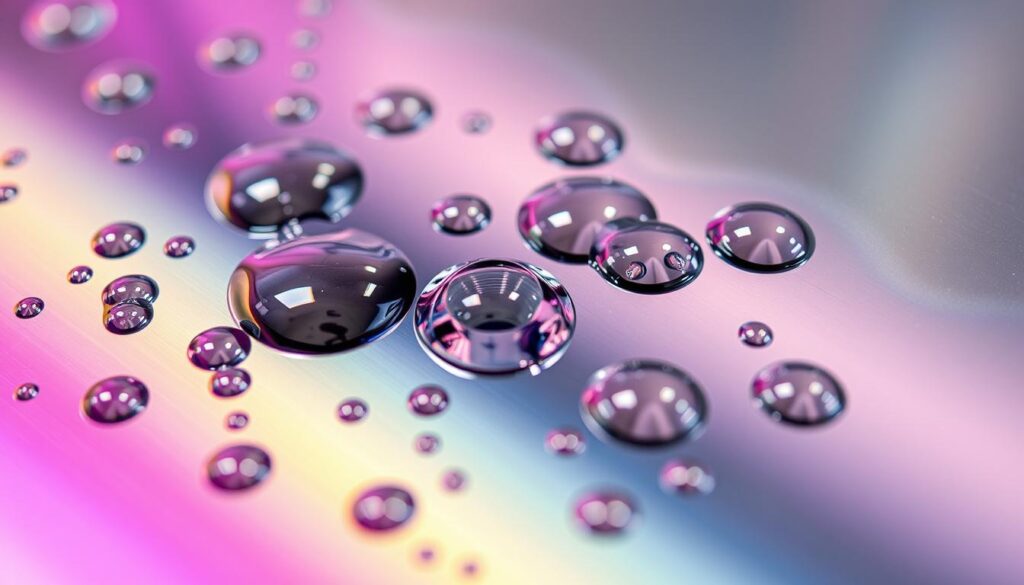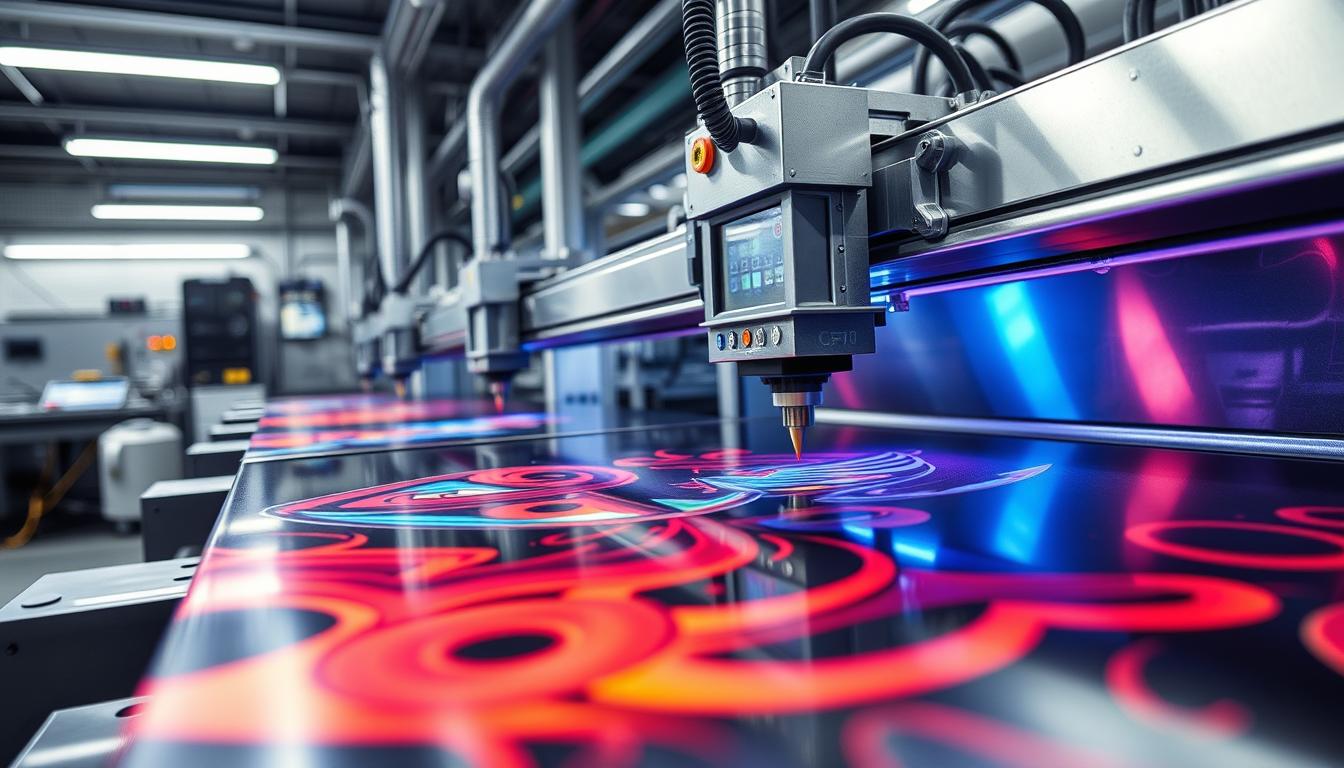UV digital printing on hard metals like iron, aluminum, and stainless steel comes with its own set of challenges. These include surface preparation, ink adhesion, and the need for specialized equipment. Achieving high-quality, durable, and consistent results is key.
One major challenge in Digital UV printing on iron is getting the surface ready. Metal surfaces are often smooth and non-porous, making it hard for UV inks to stick. Contamination, oxidation, and oils can make it even harder, leading to issues like ink bleeding or fading.
Choosing the right UV curing ink for metals is also crucial. The ink must be able to cure quickly, penetrate the metal well, and last a long time. This ensures the printed metal stays looking good for a long time.
Industrial UV flatbed printers need special features to handle metal printing challenges. They must control ink deposit well, cure it effectively, and handle curved surfaces. These factors greatly affect print quality and efficiency.
By tackling these challenges and using the right tools and techniques, businesses can make the most of Digital UV printing on iron and other metals. This allows them to create high-quality, weather-resistant, and durable products for many industrial and commercial uses.
Understanding UV Digital Printing Technology for Metal Surfaces
UV digital printing on metal surfaces is changing the game in printing and decoration. It uses special UV-curable inks and advanced systems for vibrant, durable prints on metals. This tech works on many metals like aluminum, stainless steel, copper, and brass.
It’s great for UV ink adhesion on ferrous surfaces, UV ink durability on metals, and UV ink applications on iron.
Basic Principles of UV Curing Process
The UV curing process is what makes UV digital printing special. The printer puts UV-curable ink on the metal and then hits it with UV light. This light instantly cures and bonds the ink to the metal.
This quick curing means no waiting time for drying. It results in bright, detailed, and long-lasting prints.
Types of UV Printers for Metal Applications
There are many UV printers made just for metal, like the Compress iUV600s and iUV1200s. These use LED UV tech for fast and even curing. They also save space.
Software like Compress RIP and Compress Designer makes the printing better. It helps with image quality and layout.
Key Components of Metal UV Printing Systems
UV digital printing on metals works thanks to a few key parts. These include the print head for precise ink, UV lamps for curing, and a system for handling different metals and sizes.
These parts work together smoothly. They make printing on various metals reliable and versatile.

Surface Preparation and Metal Compatibility Issues
UV printing on metals needs the right surface prep. First, clean the metal to get rid of dust, oils, and dirt. These can mess with the ink sticking. Metals react differently, so you need the right prep for each one.
Adhesion promoters help the ink stick better to the metal. For new or special materials, test them to find the best prep and promoter. Systems like PYROBOND and PYROTRACK are made for metal prep before UV printing. They make the metal ready for UV curing ink for metals, improving UV ink adhesion on ferrous surfaces.
UV flatbed printing lets you print on many materials, offering more customization options. The UV ink cures fast under UV light, making quick and bright prints on metals for Inkjet metal printing. But, each material has its own challenges and chances.
| Substrate | Advantages | Challenges |
|---|---|---|
| Plastics (Acrylic, PVC, Polycarbonate, Polypropylene) | Common substrates for UV printing | Require specific techniques to overcome issues like reflective surfaces and strong curves |
| Metals (Aluminum Sheets) | Durable and fade-resistant, popular in industrial signage | Pose challenges for UV printing, requiring specialized techniques or avoiding printing altogether |
Using RIP software and adjusting print head speed can help with tough substrates like metals. Knowing each material’s unique traits and using the right prep can unlock the full potential of UV curing ink for metals and Inkjet metal printing. This way, businesses can offer more custom options.

Digital UV Printing on Iron: Techniques and Requirements
Printing on iron is tricky because of its surface. You need the right surface treatment and special UV ink to get good results.
Surface Treatment Methods for Iron Substrates
Iron surfaces must be cleaned well to stick ink properly. This means using solvents or abrasive methods to remove dirt and oxidation. Applying adhesion promoters or primers can also help the ink stick better.
Ink Adhesion Challenges on Ferrous Materials
Choosing the right UV ink for Digital UV printing on iron is key. The ink must handle iron’s corrosion and affect on curing. Using UV ink applications on iron made for these materials helps solve adhesion issues.
Temperature and Environmental Considerations
The printing area’s temperature and environment matter a lot for UV ink durability on metals. Keep an eye on humidity, air flow, and temperature. Testing and adjusting printing settings are crucial for lasting, quality prints on iron.
Ink Formulation and Adhesion Challenges
UV digital printing on metal, especially iron, needs the right ink. The ink must stick well to the metal and stay bright and durable. It’s important for the ink to bond strongly without losing flexibility, so it doesn’t crack or peel.
To make the ink stick better to metal, special adhesion promoters and treatments are used. For example, cleaning the surface with isopropyl alcohol can help. This makes the surface ready for printing. Companies like Marabu, INX, Modico Corp., and SURA Instruments offer adhesion promoters for digital inks.
Testing the ink’s adhesion is key. Methods like Scratch Tests and Water Tests check if the ink can handle different conditions. This ensures the prints last long on metal products. Sometimes, UV screen printing works better because it uses hardeners for better adhesion.
| Ink Adhesion Enhancing Techniques | Advantages | Disadvantages |
|---|---|---|
| Surface Pretreatment (e.g., isopropyl alcohol wiping) | Removes contaminants, improves surface energy | Manual process, potential inconsistencies |
| Adhesion Promoters (e.g., Marabu, INX, Modico, SURA) | Formulated for digital inks, boosts bonding | May require manual application, adds complexity |
| Automated Flame Treatment | Consistent application, suitable for cylindrical/flat items | Requires specialized equipment, potential safety concerns |
The secret to great UV digital printing on metal is the ink’s formula and special adhesion techniques. By solving these problems, printers can make UV printing work well for metal. This means durable, bright, and lasting prints.
Quality Control and Print Consistency Problems
Printing on metal surfaces is tricky for industrial UV flatbed printers. Getting the colors right on metal needs careful setup. The metal’s surface affects how well the print looks, so adjustments are needed.
The metal’s finish, like polished or brushed, changes how prints look. Special software helps make prints look great on metal. It’s key to have good quality control to get consistent results on different metals.
Color Management on Metallic Surfaces
Getting colors right on metal is a challenge. The printer needs to be set up just right. Things like how the metal reflects light and how the ink works must be watched closely.
Print Resolution and Detail Retention
Metals can make it hard to keep details sharp in prints. To fix this, printers might need to change how they apply ink and cure it. This helps keep prints looking sharp and clear.
Surface Finish Impact on Print Quality
The metal’s finish greatly affects print quality. Printers must adjust their settings for each finish. This ensures prints look great on all kinds of metal surfaces.

Leave a Reply